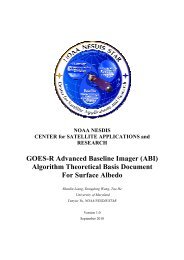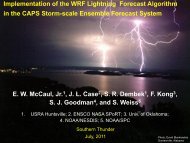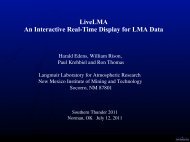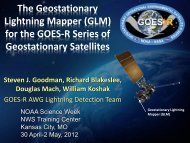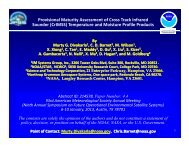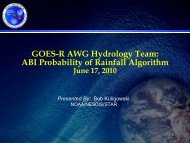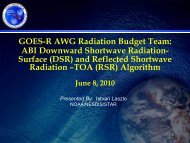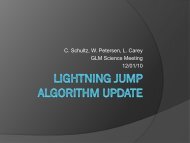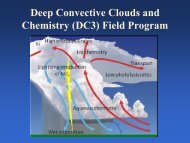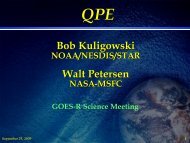GOES-R MANAGEMENT CONTROL PLAN (MCP)
GOES-R MANAGEMENT CONTROL PLAN (MCP)
GOES-R MANAGEMENT CONTROL PLAN (MCP)
Create successful ePaper yourself
Turn your PDF publications into a flip-book with our unique Google optimized e-Paper software.
The National Environmental Satellite, Data, and Information Service (NESDIS) is preparing for the<br />
procurement of the <strong>GOES</strong>-R series. This new series advances the instrument technology of <strong>GOES</strong><br />
satellites by several decades and introduces new space and ground technology. These technological<br />
advances will improve our Nation’s ability to monitor and forecast weather, environmental and space<br />
phenomena. It will provide a greater than three-fold increase in the types of products produced. <strong>GOES</strong>-R<br />
will expand the nation’s capability to acquire, process and disseminate to central processing centers and<br />
direct users, environmental data on an extensive spatial range (global, regional, and local) within a variety<br />
of time scales (minutes to days). Examples of these include global imagery; cloud and precipitation<br />
parameters; atmospheric profiles of temperature, moisture, wind, aerosols and ozone; surface conditions<br />
concerning ice, snow, and vegetation; ocean parameters of sea temperature, color and state; solar and insitu<br />
space environment conditions. This data is critically needed for:<br />
• Severe storm watches and warnings<br />
• Tropical cyclones<br />
• Hydrologic forecasts<br />
• Forecasts of the ocean structures<br />
• Solar and space environment forecasts<br />
• Aviation and marine forecasts<br />
• Forecasts of ice conditions<br />
• Seasonal and inter-annual climate forecasts<br />
• Architecture studies for monitoring of climate variability<br />
• Assessment of long-term global environmental change<br />
• Environmental air quality monitoring and emergency response<br />
• Detection and analysis of fires and volcanic eruptions<br />
The <strong>GOES</strong>-R series acquisition includes five different environmental instrument suites, spacecraft and<br />
launch services, ground systems, and the end-to-end systems integration to support <strong>GOES</strong>-R design,<br />
fabrication, testing, launch, and operations.<br />
Instrument development was initiated early for all five instruments for formulation of design and risk<br />
mitigation/ reduction activities. These instruments are: (1) Advanced Baseline Imager (ABI); (2)<br />
Hyperspectral Environmental Suite (HES); (3) Solar Imaging Suite (SIS); (4) Space Environmental In-<br />
Situ Suite (SEISS); (5) Geostationary Lightning Mapper (GLM) and (6) Magnetometer (MAG).<br />
Instrument efforts began in 2001 with the award, by NASA for NOAA, of three firm fixed price (FFP)<br />
PDRR contracts for the ABI. FFP PDRR contracts for the HES and SIS were awarded in FY04, SEISS<br />
was awarded in FY05, and GLM was awarded in FY06. A cost plus contract for ABI A&O contract was<br />
awarded by GSFC in FY04. HES development was discontinued in 2006.<br />
The <strong>GOES</strong>-R program completed the Program Definition and Risk Reduction (PDRR) phase with three<br />
developer contractor teams completing a series of studies to refine system requirements and architectural<br />
design. In December 2006, NOAA decided to split the procurement (Acquisition and Operations (A&O)<br />
phase) into Space and Ground segment contracts, led by the NASA Flight Project and NOAA Ground<br />
Segment Project respectively. The A&O contract awards are expected in 2008, with a first launch<br />
readiness expected in December 2014.<br />
Page 75 of 75




